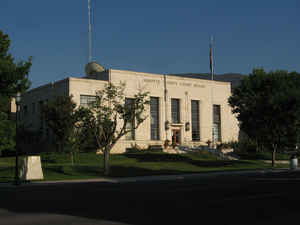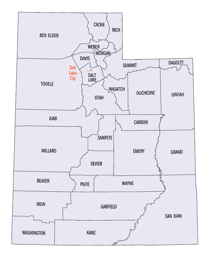Utah Counties
There are twenty-nine counties in the State of Utah. There were originally seven counties established under the provisional State of Deseret in 1849: Davis, Iron, Sanpete, Salt Lake, Tooele, Utah, and Weber. The Territory of Utah was created in 1851 with the first territorial legislature meeting from 1851-1852. The first legislature re-created the original counties from the State of Deseret under territorial law as well as establishing three additional counties: Juab, Millard, and Washington. All other counties were established between 1854 and 1894 by the Utah Territorial Legislature under territorial law except for the last two counties formed, Daggett and Duchesne.Sanpete County, Utah
Sanpete County Education, Geography, and History

Sanpete County is a county located in the state of Utah. Based on the 2010 census, the population was 27,822. Its county seat is Manti, and its largest city is Ephraim. The county was created in 1850.
Etymology - Origin of Sanpete County Name
It was named for the Ute chief Sanpitch, which was changed to Sanpete. According to William Bright, the name comes from the Ute word saimpitsi, meaning "people of the tules"
Demographics:
County QuickFacts: CensusBureau Quick Facts
Sanpete County History
Set in the northwest corner of the High Plateaus, Sanpete Valley is tucked between the higher Wasatch Plateau to the east and the San Pitch or Gunnison Plateau to the west. The valley drains south to the Gunnison Valley section of the Sevier River which then drains northwest to the Great Basin. Mount Nebo, at the southern end of the Wasatch Mountains, across the border in Juab County, is prominently viewed in northwest Sanpete and its foothills divide Sanpete Valley into two northern prongs.Sanpete's prehistoric inhabitants include the Fremont agriculturalists. Mounds have yielded small stone and mud-waIled structures and pottery, points, and metates, but Sanpete has not been systematically studied like its neighbors south and east. Ute chief Wakara enslaved the San Pitch Indians who gathered and hunted in the local marshes and canyons. The Utes had adopted the horse and other elements of Plains Culture and ranged widely with an apparent winter base in Sanpete. Wakara invited Mormon settlement, perhaps for the resources it would bring, and then opposed it in a war of 1853-54 which caused a period of "forting up" and abandonment of towns. The Black Hawk War of 1863-68 brought a more serious and prolonged period of guerrilla raids. The first Mormon settlers arrived in fall 1849. They chose the Manti site because of a nearby warm spring, the extensive limestone quarries (later exploited commercially) and the fine farming and grazing lands nearby. The larger towns were established in the first decade of settlement. Scandinavian immigrants soon made up a sizeable minority and elements of their culture and humor remain today. The towns peaked in population about 1900-1910 and declined until the 1970s. The county was created in 1830, enlarged, and later reduced in size. Sanpete's location at Utah's geographical heart masks its isolation. Much interstate and recreational traffic bypass it. None of the small, scattered towns has developed as a center of economic development. Since settlement, Sanpete's economy has been agriculturally based. In its first few decades it served as Utah's granary. Cattle have always been important but currently only a few large dairies survive. New beef breeds from Switzerland and France have joined the traditional Hereford and Angus to produce lower fat, faster-growing animals. Sheep dominated the local economy from the 1880s through the 1920s, and Sanpete played a prominent part in world markets for a time. Turkeys, grown casually as a farmyard fowl, became a cooperative, integrated industry in response to the 1930s depression. Today they rule the roost in Sanpete, which ranks among the top ten turkey-producing counties in the country. Snow College, a two-year institution in Ephraim, plays an important role in the local economy.
*Sources: Beehive History 14: Utah Counties. 1988. Utah State Historical Society, 300 Rio Grande, Salt Lake City, UT 84101-1182.
Geography: Land and Water
As reported by the Census Bureau, the county has a total area of 1,603 square miles (4,151 km2), of
which, 1,588 square miles (4,113 km2) of it is land and 15 square miles (38 km2) of it (0.91%) is water.
Sanpete is located in the geographical center of Utah.
Sanpete is bounded along its eastern side by the Wasatch Plateau (sometimes known as the Manti Mountains).
The Wasatch Plateau rises to elevations of approximately 11,000 feet (3,300 m). Most of the Wasatch Plateau
is encompassed by the Manti Division of the Manti-La Sal National Forest. Runoff from the western slopes of
these mountains provides water to the county's cities and agricultural areas. Central Sanpete is dominated
by the Sanpete Valley (sometimes known as the Sanpitch Valley), where most of the county's cities are
located. The western side of the valley is bounded by the lower and drier Sanpitch Mountains, which also
form part of the western boundary of the county. The Sanpitch River, runs from north to south through
Sanpete and empties into the Sevier River in southwestern Sanpete. This portion of the Sevier River Valley
is known as Gunnison Valley.
Neighboring Counties
Bordering counties are as follows:
- Utah County, Utah - (north)
- Carbon County, Utah - (northeast)
- Emery County, Utah - (east)
- Sevier County, Utah - (south)
- Millard County, Utah - (southwest)
- Juab County, Utah - (northwest)
Education







